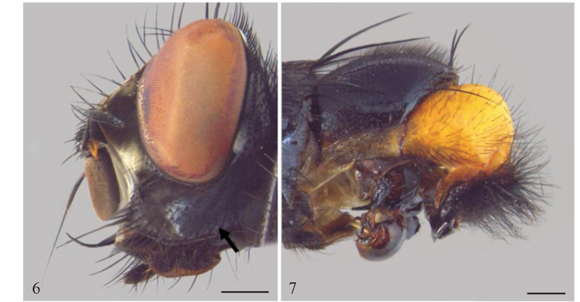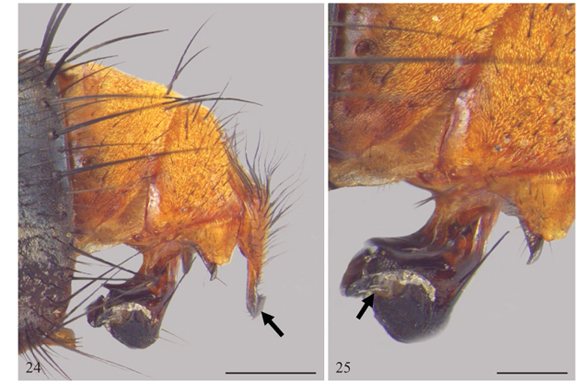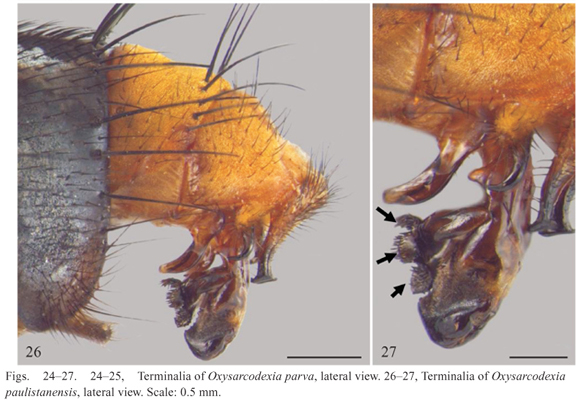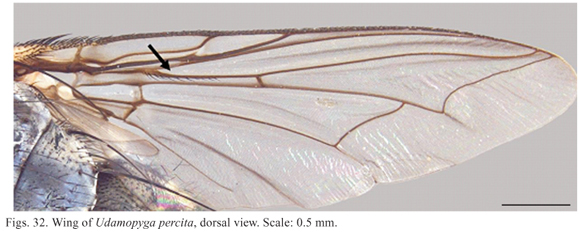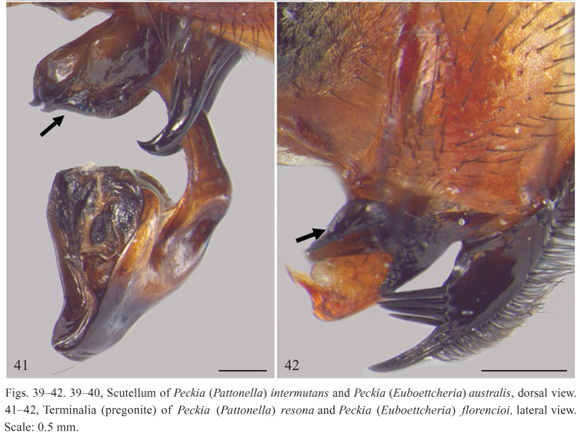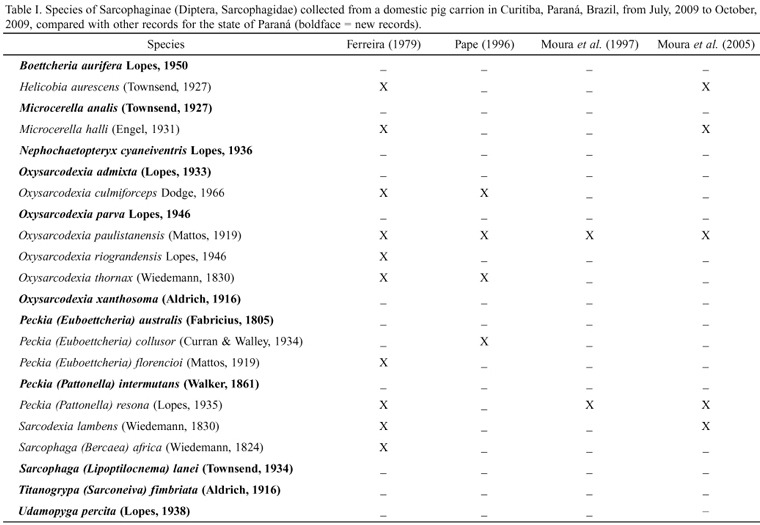Abstracts
Pictorial identification key for species of Sarcophagidae (Diptera) of potential forensic importance in southern Brazil. Species of the subfamily Sarcophaginae are important to forensic entomology due to their necrophagous habits. This contribution presents a pictorial key for the identification of 22 Sarcophaginae species in 10 genera that are commonly found in southern Brazil. Photographs of the main structures used in species identification, mainly from the male terminalia, are provided.
Flesh flies; medico-legal entomology; morphology; taxonomy
Chave pictórica para a identificação das espécies de Sarcophagidae (Diptera) de potencial importância forense do sul do Brasil. Espécies da subfamília Sarcophaginae são importantes para a entomologia forense devido ao seu hábito necrófago. Este trabalho apresenta uma chave pictórica para a identificação de 22 espécies de Sarcophaginae de 10 gêneros encontradas na região sul do Brasil. São fornecidas fotografias dos principais estruturas das espécies, principalmente da terminália masculina.
Entomologia médico-legal; morfologia; sarcofagídeos; taxonomia
Pictorial identification key for species of Sarcophagidae (Diptera) of potential forensic importance in southern Brazil
Karine Pinto e VairoI; Cátia Antunes de Mello-PatiuII; Claudio J. B. de CarvalhoI
IDepartamento de Zoologia, Universidade Federal do Paraná, Caixa Postal 19020, 81031970 Curitiba-PR, Brazil. karine_vairo@yahoo.com.br, cjbcarva@ufpr.br
IIDepartamento de Entomologia, Museu Nacional, Universidade Federal do Rio de Janeiro, 20940040 Rio de Janeiro-RJ, Brazil. catiapatiu@oi.com.br
ABSTRACT
Pictorial identification key for species of Sarcophagidae (Diptera) of potential forensic importance in southern Brazil. Species of the subfamily Sarcophaginae are important to forensic entomology due to their necrophagous habits. This contribution presents a pictorial key for the identification of 22 Sarcophaginae species in 10 genera that are commonly found in southern Brazil. Photographs of the main structures used in species identification, mainly from the male terminalia, are provided.
Keywords: Flesh flies; medico-legal entomology; morphology, taxonomy.
RESUMO
Chave pictórica para a identificação das espécies de Sarcophagidae (Diptera) de potencial importância forense do sul do Brasil. Espécies da subfamília Sarcophaginae são importantes para a entomologia forense devido ao seu hábito necrófago. Este trabalho apresenta uma chave pictórica para a identificação de 22 espécies de Sarcophaginae de 10 gêneros encontradas na região sul do Brasil. São fornecidas fotografias dos principais estruturas das espécies, principalmente da terminália masculina.
Palavras-chave: Entomologia médico-legal; morfologia; sarcofagídeos, taxonomia.
The widely distributed Sarcophagidae includes approximately 2510 extant species, most from warm climates. Three subfamilies have been recognized: Miltogramminae, Paramacronychiinae and Sarcophaginae. The latter is the most diverse, and includes species that are important to forensics (Pape 1996).
Sarcophaginae larvae feed on excrements and decomposing organic matter (Byrd & Castner 2001), including carcasses and corpses. Additionally, some species are mechanical vectors of pathogens or are known to cause myiasis in vertebrates (Zumpt 1965).
Despite their importance, species in Sarcophaginae are difficult to separate based on external characters, and can only be successfully identified after careful analysis of the male genitalia (de Carvalho & Mello-Patiu 2008). Their external morphology is either too uniform or vary too much, being generally useless for identification purposes.
Sarcophagidae have been found on animal carcasses throughout the decomposition process, being slightly less ubiquitous only during the advanced stages of decomposition (Barros et al. 2008).
Experiments using animal carcasses have proved important to forensics because they provide data on the local insect fauna relevant to the decomposition process (Barbosa et al. 2010). Undeniably, forensic entomology can only be applied in areas where the composition and biology of the insect fauna at different stages of carrion decomposition are already known.
Medicolegal forensic entomology is able to provide relevant and important data during a criminal investigation, such as whether a corpse has been moved or not (Anderson 2005), or whether the victim was a drug user or had been poisoned (Introna et al. 2001). It can also reveal instances of negligence towards incapacitated people or animals (Benecke & Lessing 2001; Benecke et al. 2004; Anderson & Huitson 2004). Most importantly, however, forensic entomology can help determine the amount of time a victim has been exposed to the environment, facilitating the estimate of the post-mortem interval (PMI) (Oliveira-Costa & Mello-Patiu 2004; Pujol-Luz et al. 2006).
This work presents an identification key to the species of Sarcophagidae found in the municipality of Curitiba, state of Paraná, southern Brazil. In order to facilitate the use of the key by criminal investigators and researchers in general who are not taxonomists, the main features of the male terminalia are illustrated through photographs.
MATERIAL AND METHODS
Specimens were collected in a "capão" with approximately five acres, located in Curitiba-PR (25º25'S and 49º14'W) at the campus of the Centro Politécnico, Universidade Federal do Paraná. The area is a remnant of mixed ombrophilous forest with three well-defined strata, moderately humid soil, and low elevations. The soil has a high percentage of clay, hindering the absorption of water from the rain. It is also acidic due to the large amount of ferns and poor in boron, due to the presence of Baccharis trimera ("carqueja"), characterizing the vegetation as pioneer (Mise et al. 2007).
We used a 25 kg domestic pig carrion (Sus scrofa Linnaeus) in our experiment. The animal was killed by a wound in the heart, and immediately placed in a suspended cage (2 m high) to avoid destruction by large necrophagous animals. We then covered the cage with a trap made of white translucent nylon fabric reaching about 50 cm from the ground to allow insects to enter from underneath. Adult insects that visited the carrion were collected from July 21, 2009 to October 16, 2009 (when adult stages were no longer found). The flies were caught with the help of lethal vials containing ethyl acetate. After collecting, we sorted and mounted the specimens and exposed the male terminalia with the help of entomological pins (Lopes 1973).
In the key we have adopted the terminology of Cumming & Wood (2009) for the external and genital morphologies, and Silva & Mello-Patiu (2010) for some phallic structures characteristic of Sarcophagidae. The general classification and geographic distribution of species follow Pape (1996). Photographs were taken with a Leica DFC 500 digital camera and an Auto-Montage Pro Digital Imaging System (Syncropy), using a Leica MZ16 stereomicroscope.
The experiment was authorized by the "Comitê de Ética em Experimentação Animal (CEEA)", biological sciences branch, Universidade Federal do Paraná, process number 23075.083831/200987.
RESULTS
We identified all adult males into 22 species belonging to 10 different genera (Tab. I). According to the distributional records of Ferreira (1979), Pape (1996) and Moura et al. (1997, 2005) (Tab. I), some species found by us represent new records for the state of Paraná.
Figure 1 is a general sketch of the male terminalia showing the main structures used in species identification. The terminalia of each species and other morphological characters used in the key are detailed in figures 247, as indicated in the key.
Key to the identification of the species of Sarcophagidae that occur in Curitiba (adult males)
(Fig. 2) .......................................................................................... 2
(Jalisco), Peru ........................Titanogrypa (Sarconeiva) fimbriata (Aldrich)
São Paulo) ...................................Nephochaetopteryx cyaneiventris Lopes
vesica of phallus variously shaped ....................................................... 8
Paraguay ........................................... Oxysarcodexia culmiforceps Dodge
São Paulo) ............................................. Oxysarcodexia admixta (Lopes)
Peru) ............................................. Oxysarcodexia thornax (Wiedemann)
São Paulo) ................................................... Oxysarcodexia parva Lopes
(Santiago) .................................... Oxysarcodexia paulistanensis (Mattos)
Peru ............................................... Oxysarcodexia xanthosoma (Aldrich)
Tobago (Tobago) .................................. Sarcodexia lambens (Wiedemann)
spine-pad ..................................................................................... 15
São Paulo)................................................... Udamopyga percita (Lopes)
São Paulo) .................................................... Boettcheria aurifera Lopes
São Paulo) ......................... Sarcophaga (Lipoptilocnema) lanei (Townsend)
Paraguay ................................ Sarcophaga (Bercaea) africa (Wiedemann)
Catarina, São Paulo) ............................. Peckia (Pattonella) resona (Lopes)
Trinidad) .................................... Peckia (Pattonella) intermutans (Walker)
São Paulo) ............................... Peckia (Euboettcheria) florencioi (Mattos)
Paraguay ................................ Peckia (Euboettcheria) australis (Fabricius)
DISCUSSION
This contribution provides a quick and efficient tool to identify the species that visit pig carcasses in the region of Curitiba, Paraná. Given the species' distributions, our key may be extrapolated to other areas in the southern and southeastern Brazil.
Titanogrypa (Sarconeiva) fimbriata and Udamopyga percita are mollusk parasitoids (Lopes 1940) and their presence in our samples are most likely accidental, as each species was collected only once by us. However, they had not been previously recorded in the region. Even though taxonomical studies are important to the biological sciences in general, they are particularly relevant to forensics, because erroneous species identifications can mislead expert reports. For this reason, basic taxonomic research is essential to the progress of this science in the country.
ACKNOWLEDGEMENTS
We thank TaxonLine Rede Paranaense de Coleções Biológicas- for the photographs in this work; Conselho Nacional de Desenvolvimento Científico e Tecnológico (CNPq) for a MS (KPV) and a postdoctoral (CAMP) scholarships, and a research grant (CJBC process number 300873/20085).
Received 20/1/2011; accepted 16/6/2011
Editor: Marcia Souto Couri
- Anderson, G. S. 2005. Forensic Entomology, p. 135164. In: S. H. James; J. J. Nordby (eds.). Forensic Science An Introduction to Scientific and Investigative Techniques. xxxi + 778 p.
- Anderson, G. S & N. R. Huitson. 2004. Myiasis in pet animals in British Columbia: The potential of forensic entomology for determining duration of possible neglect. Canadian Veterinary Journal 45: 993998.
- Barbosa, R. R.; C. A. Mello-Patiu, A. Ururahy-Rodrigues; C. G. Barbosa & M. M. C. Queiroz. 2010. Temporal distribution of ten calyptrate dipteran species of medicolegal importance in Rio de Janeiro, Brazil. Memórias do Instituto Oswaldo Cruz 105: 191198.
- Barros, R. M; C. A. Mello-Patiu & J. R. Pujol-Luz. 2008. Sarcophagidae (Insecta: Diptera) associados à decomposição de carcaças de Sus scrofa em área de cerrado do Distrito Federal, Brasil. Revista Brasileira de Entomologia 52: 606609.
- Benecke, M. & R. Lessing. 2001. Child neglect and forensic entomology. Forensic Science International 120: 155159.
- Benecke, M.; E. Josephi & R. Zwihoff. 2004. Neglect of the elderly: forensic entomology cases and considerations. Forensic Science International 146: 195199.
- Byrd, J. H. & J. L. Castner. 2001. Insects of Forensic Importance, p. 4379. In: J. H. Byrd; J. L. Castner (ed.). Forensic Entomology The Utility of Arthropods in Legal Investigations. xvii +418 p.
- Cumming, J. M. & D. M. Wood. 2009. Adult Morphology and Terminology, p. 950. In: B. V. Brown; A. Borkent; J. M. Cumming; D M Wood; N. E. Woodley & M. A. Zumbado (ed.). Manual of Central American Diptera. xi + 714 p.
- de Carvalho, C. J. B. & C. A. Mello-Patiu. 2008. Key to the adults of the most common forensic species of Diptera in South America. Revista Brasileira de Entomologia 52: 390406.
- Ferreira, M. J. M. 1979. Sinantropia de Dípteros Muscoideos de Curitiba. II: Sarcophagidae. Revista Brasileira de Biologia 39: 773781.
- Introna, F.; C. P. Campobasso & M. L. Goff. 2001. Entomotoxicology. Forensic Science International 120: 4247.
- Lopes, H. S. 1940. Contribuição ao conhecimento do gênero Udamopyga Hall e de outros Sarcophagideos que vivem em moluscos no Brasil (Diptera). Revista de Entomologia 11: 925955.
- Lopes, H. S. 1973. Collecting and rearing Sarcophagid flies (Diptera) in Brazil during forty years. Anais da Academia Brasileira de Ciências 45: 279291.
- Mise, K. M.; L. M. de Almeida & M. O. Moura. 2007. Levantamento da fauna de Coleoptera que habita a carcaça de Sus scrofa L. em Curitiba, Paraná. Revista Brasileira de Entomologia 51: 358368.
- Moura, M. O.; C. J. B. de Carvalho & E. L. A. Monteiro-Filho. 1997. A Preliminary Analysis of Insects of Medico-Legal Importance in Curitiba, State of Paraná. Memórias do Instituto Oswaldo Cruz 92: 269274.
- Moura, M. O.; C. J. B. de Carvalho & E. L. Monteiro-Filho. 2005. Estrutura de comunidades necrófagas: efeito da partilha de recursos na diversidade. Revista Brasileira de Zoologia 22: 11341140.
- Oliveira-Costa, J. & C. A. Mello-Patiu. 2004. Application of forensic entomology to estimate of the postmortem interval (PMI) in homicide investigations by the Rio de Janeiro Police Department in Brazil. Anil Aggrawal's Internet Journal of Forensic Medicine and Toxicology 5: 4044.
- Pape, T. 1996. Catalogue of the Sarcophagidae of the world (Insecta: Diptera). Memoirs on Entomology. Florida, International Associated Publishers, 558 p.
- Pujol-Luz, J. R.; H. Marques; A. U. Rodrigues; J. A. Rafael; F. H. A. Santana; L. Chaves & R. Constantino. 2006. A Forensic Entomology Case from the Amazon Rain Forest. Journal of Forensic Science 51: 13.
- Silva, K. P & C. A. Mello-Patiu. 2010. New species of Dexosarcophaga Townsend from Panama with an illustrated key to species of the subgenus Bezzisca (Diptera: Sarcophagidae). Journal of Natural History 44: 89106.
- Zumpt, F. 1965. Myiasis in man and animals in the Old World. London, Butterworths, 267 p.
Publication Dates
-
Publication in this collection
30 Sept 2011 -
Date of issue
Sept 2011
History
-
Accepted
16 June 2011 -
Received
20 Jan 2011

